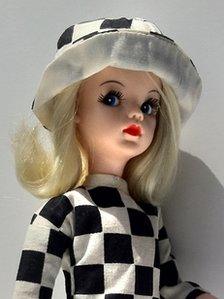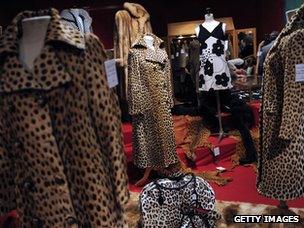How Barbie crushed Sindy
- Published

Her 50th birthday is around the corner and she can no longer keep up with fashion. Can anyone save Sindy, the doll created to be a British rival to Barbie?
Wholesome, demure, Sindy was the fashion doll created as a British girl-next-door alternative to the rather more glamorous and sexy American Barbie. She was the UK's most popular doll with about 80% of the fashion doll market at her peak in 1985.
But time has not been kind.
Sindy has been taken to court, she has been sidelined by her racy American rivals and, when Woolworths went under in 2009, she disappeared from the British High Street altogether.
Fifty years on, Pedigree Toys, the Exeter-based company which created Sindy, can no longer keep up with the demands of fashion and is looking for a firm to take her on to see if Sindy's values can work once again with the nation's girls.
But they have not lost faith in the doll, says Jerry Reynolds, of Pedigree Toys.
The creators of Sindy are looking for another company to help them relaunch the doll for a new generation
"Sindy is the girl-next-door, your friend... and she's been a comfort blanket to little girls, not just in Britain but across Europe and we believe those qualities stand the test of time."
But Sindy has had a difficult time of it. In the 1960s and 70s, she had it all - the Mary Quant bob, a moped and a pony. She wore outfits that made her look as if she had just stepped out of Biba or any of the boutiques of Carnaby Street, and her image was that of the carefree girl about Swinging London.
But in the 1980s her popularity began to decline. The shoulder pads and high-gloss glamour of Barbie began to make Sindy look a bit old-fashioned. The response was a makeover that made her look more like Barbie and provoked years of legal battles. Mattel, the makers of Barbie, felt their product was being copied and in 1994 Sindy's face was changed again.
Helen Carter, an avid Sindy collector and fashion lecturer, feels it was a disaster.
"[The original Sindy] has got such a warm, friendly expression on her face, she's got side-glancing eyes. She's not challenging in any way, she's pretty, she's the English Rose.

The eyes once had it
"Whereas [1990s Sindy] has got this grin, these forward-facing eyes. She doesn't look human, she looks like an alien... she's also got the Barbie bosoms. She was taken right away from what the intrinsic Sindy values were, which is now what we hope to back to. It's really important to go back to those values."
The original decision to create a British alternative to Barbie grew out of a feeling that girls in the UK would not relate to Barbie's grown-up looks and American lifestyle.
Through the 1960s and 70s Barbie had a telephone, drove a car and had, at one point, a job as an astronaut. Sindy had a cooker that made the sound of sizzling bacon. She was also younger and, as Carter says, not quite so pneumatic.
Pedigree thinks everything changed with arrival of the TV programmes Dallas and Dynasty which helped reset children's tastes. The dolls that sold were increasingly glossy, tanned and glamorous. The remodelled Sindy of the late 1980s was made thinner, her chest bigger and her legs longer - but Barbie prevailed.
However, over the past 10 years, even Barbie has been caught out by the arrival of Bratz dolls. The American Psychological Association, in a taskforce report on the sexualisation of girls, singled out Bratz dolls for their "sexualised clothing" of "miniskirts, fishnet tights and feather boas".
So is there a market for a return to a rather more innocent Sindy?
Freelance toy designer Rachel Godfroy thinks there is.
"Talking to some of my mum friends who have girls who are six or seven years old, they are looking for something that isn't brash, which isn't tarty. They are looking for something that is wholesome and good that they can give to their daughters' friends and not think, 'Is this a bit inappropriate?'"

Sindy could go retro to cash in on the popularity of vintage looks
The problem is that what a mother wants may not be what their daughters want, and Sindy's decline has been a long one.
A joint venture with Woolworths came to an end when the firm went under in 2009 and that was the end of Sindy on the High Street. Now, three years on, Pedigree thinks it can do no more and it is looking for a company to take her on which might be able to keep her wholesome but also up to date.
"We don't really have the skills to keep up with all the fashions," says Jerry Reynolds. "If it's a retailer or a manufacturer, they have to change her clothes every year to keep up with trends."
The problem will be deciding which fashions to dress her in - ones that appeal to mothers anxious to avoid tattoos and anything too suggestive, but also looks that little girls want to spend their pocket money on to get the cash tills ringing again.
- Published3 July 2012